- Performance
- Price
- Ease of use
- Support
Summary
The Jump Manual is one of the most popular programs on the market, and for a good reason – it’s based on sound scientific principles and can bring great results if you’re able to finish it.
However, the huge time commitment required, as well as the necessity for gym equipment, make this program more suited for professional athletes, and difficult to follow for someone who lacks the time or resources.
Having said that, it’s one of the most effective programs for jumping higher.
If you’re looking to add SERIOUS inches to your vertical and have the time to invest, The Jump Manual is one of the best programs you could go for.
Table of Content
- 1 How I Came Across This Program
- 2 What Is The Jump Manual?
- 3 Who Is Jacob Hiller?
- 4 How Does The Jump Manual Work?
- 5 The 9 Variables of Vertical Jump
- 6 The Science Behind The Jump Manual
- 7 The Jump Manual Workouts
- 8 My Results
- 9 The Pros
- 9.1 Solid Strength Training Routine
- 9.2 Increases Your Max-Vertical Potential
- 9.3 Solid Warm-Up Routine
- 9.4 Packed with Concise Info
- 9.5 Good Option for People with Injuries
- 9.6 100% Money-Back Guarantee
- 9.7 Weight Room Alternatives
- 9.8 Science-Based Training Approach
- 9.9 Nutrition Plan Designed for Maximum Gains
- 9.10 Best Program for Preventing Injuries
- 9.11 Overall Basketball Performance Improvement
- 10 The Cons
- 11 Will the Program Work for You?
- 12 How Many Inches Will You Gain?
- 13 Bonuses
- 14 Summary
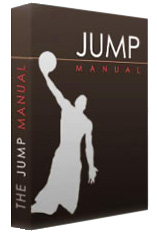 The Jump Manual has been the gold standard for dunkers since its release back in 2007…
The Jump Manual has been the gold standard for dunkers since its release back in 2007…
But is it still your best choice for becoming a +40 inch dunking machine?
Can the program really add up to 10 inches to your vertical in just three months?
Find out exactly what you’ll need to do in order to become an explosive dunker, and how The Jump Manual earned the reputation of one of the best vertical jump programs on the market.
Ready to begin?
Here we go.
How I Came Across This Program
As someone who’s really passionate about basketball, I’ve always looked for ways to improve my game.
At six foot, I was always the short guy on my team, which made me feel small and out of place on the court.
It really brought me down…
I wanted to be able to dunk like all those big guys I was playing up against… but my vertical was never my strength on the court, to say the least.
I didn’t think I’d be able to get a high enough vertical to dunk – I failed too many times in the past when doing programs such as Air Alert 3, and I was simply losing hope.

But lucky for me, I was wrong.
In this review, I’m going to share with you my experience with The Jump Manual and how it helped me increase my vertical to a whopping 42 inches (no, it’s not a typo).
I will show you how this program works in practice and go through everything in detail.
Let’s jump right into it.
What Is The Jump Manual?
The Jump Manual is a professional vertical leap training program that was created by Jacob Hiller.
It’s a full training package that teaches you how to systematically increase your vertical jump and guides you through each step of the way.
The program guarantees to add at least 10 inches to your vertical, which is a BIG promise to make.
But can The Jump Manual deliver on it?
The short answer is…
YES!
It uses tried and tested scientific methods that have worked for thousands of athletes. Therefore, if you’re able to follow through with the instructions, you’re all but guaranteed to have an explosive vertical when you’re done.
And the person behind The Jump Manual has impressive credentials too…
It was developed by Jacob Hiller, a certified trainer who has mastered the art of vertical jumping and has taught thousands of others how to do it as well.
Who Is Jacob Hiller?
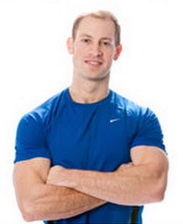
Jacob Hiller is the creator of The Jump Manual. He’s a world renowned trainer who’ve worked with thousands of athletes, some of which are pro players and even Olympic athletes.
Hiller is one of the few coaches in the world who specialize entirely in the field of vertical leap training, and he has helped thousands of athletes improve their vertical jump over the years.
With more than 15 years of experience under his belt, Jacob has mastered the art of vertical jumping down to a science.
And through the course of his training, he has gained some profound insights about jumping high.
So when it comes to increasing your vertical jump, Hiller is one of the best guys you could learn from.
You see, there’s so much misinformation that gets spread around on the internet these days that it’s easy to get confused by the false promises spread by marketing “gurus” and people who have little to no knowledge in the field.
That is not the case here though.
Hiller is a certified personal trainer by the ACE (American Council on Exercise), and his methods and techniques are tried and true. So you can be sure that you’re getting the right information from a legit source.
In The Jump Manual, he busts a lot of these myths and shows you exactly what works and what doesn’t, so you can focus on the things that do, and avoid all the pitfalls that lead to failure/mediocre results.
How Does The Jump Manual Work?
So what’s the science behind this program?
Well, here’s a short 3-minute video that explains in a nutshell how the program works:
The 9 Variables of Vertical Jump
Throughout the years of developing his manual, Hiller has discovered nine different variables that affect your vertical leap.
And here’s the kicker…
Almost all the programs you see today concentrate on just ONE or TWO of these variables.
Yep, that’s the truth… most programs out there are pretty narrow in their approach.
The Jump Manual, however, targets all of these variables – It’s the only program I’ve seen that takes a multi-facet approach… therefore, it is much more effective.
Hiller explains that the nine variables combine to create a “synergistic effect”, meaning that as you improve each facet of your vertical jump, it will have a positive effect on all of the others as well.
At the same time, if one of the variables isn’t developed enough, your ability to jump high WILL be limited.
And while you don’t need to utilize all of them to improve your jumping ability, you will only jump as high as the weakest link in your vertical will allow.
In other words…
Your vertical jump is only as strong as its weakest link.
And what are these variables?
Let’s go over them one by one.
1. Strength
This one’s pretty self-explanatory, right? If you don’t have strength and your legs are weak, you’re limited in how high you can jump.
The way you improve your strength is by doing strength training.
But not all strength training is right for vertical jump improvement.
Jump Manual focuses on developing the fast-twitch muscle fibers (otherwise known as Type II fibers), which are directly responsible for how quickly your muscles are able to generate force.
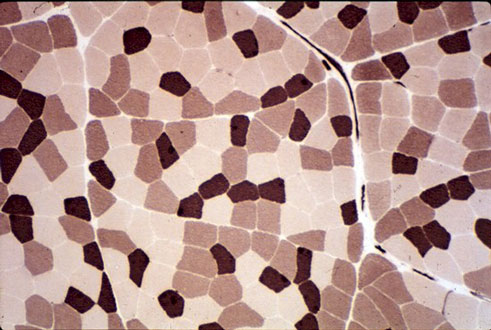
2. Quickness
Strength won’t matter if you’re unable to generate it quickly. The faster your muscles can contract, the more explosive your jump will be.
3. Muscle Recruitment
If your muscle fibers aren’t recruited to their max, your ability to jump is decreased.
The Jump Manual emphasizes max-effort training to make sure that your body is conditioned to use every muscle fiber and maximize your jumping ability.
4. Form
When performing jump movements, your body uses numerous muscle groups. Thus, making sure they all work together hand in hand in a synergistic way is essential.
Developing proper form and improving your technique helps to do just that.
5. Nutrition
An often overlooked aspect of vertical jump training is getting the right nutrients to allow your muscles to grow and recover. The same applies to eating before and after workouts. You need to give your body the fuel to perform at peak level.
6. Flexibility
Flexibility is crucial from a few standpoints.
First, your muscles need the full range of motion in order to contract as powerfully as possible (a long muscle can contract more than a short muscle).
Second, none-flexible muscles and tissues are highly prone to injury.
And third, the resistance of opposing muscles (agonist and antagonist) has to be reduced in order to allow the muscles to contract uninterruptedly.

Therefore, it is imperative that you work on flexibility when training for the vertical jump, which is why there’s a huge emphasis on it in the manual.
7. Balance
If your joints and muscles aren’t stable, other parts of your body are forced to absorb the force generated when you jump, which means you’re wasting a significant part of your vertical leap potential.
8. Body Composition
Weight plays a huge role in your jump – every extra pound you carry reduces your jumping potential.
Luckily, the program provides tangible solutions on making sure your body is in peak shape for maximum jumping ability.
9. Genetics
Finally, the genes that you inherit from your parents also play a somewhat important role.
Some people have lots of fast twitch fibers and can jump high naturally, while others struggle.
Fortunately, with a program like The Jump Manual you can retrain your slow-twitch muscle fibers to act more like fast-twitch fibers, which can turn almost anyone into an explosive leaper.

These nine components play a role in how high you jump, and The Jump Manual goes deep into addressing each and every one of them to make sure that you have the best chances to succeed.
Most other vertical training programs only deal with just one or two of these aspects, barely touching on the others, which greatly limits your chances of dunking.
The bottom line is this:
You will not find a more detailed and complete vertical jump program than The Jump Manual!
It covers everything you need to know about the mechanics of vertical jumping, and more.
The Science Behind The Jump Manual
While The Jump Manual is a long and comprehensive program that contains pages upon pages of science-based training approaches, surprisingly, that’s not what makes it so successful for so many people worldwide.
The real reason is in fact much simpler.
Hiller took hundreds of the most significant research papers, studies, and training manuals in the field of vertical jumping, and then tested their theories and distilled that information into a 14-day training routine that can be understood, absorbed, and completed by anyone.
Here’s a quick preview of how the members area looks:
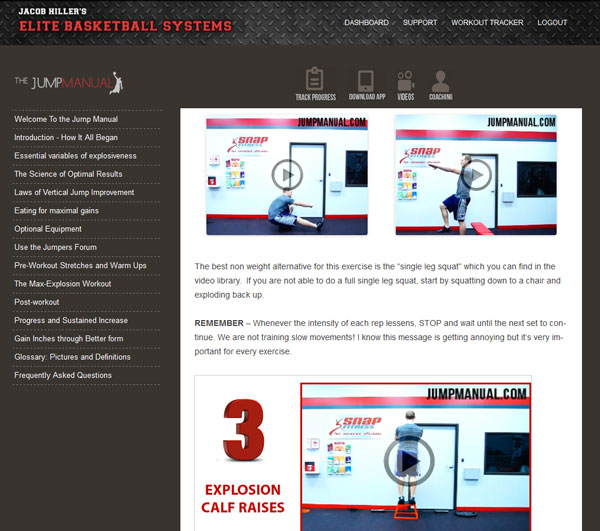
You can see just how friendly and simple it is – everything is divided into sections, and it’s easy to navigate your way through the site.
This is a luxury that previous generations of aspiring dunkers did not have.
Even 15 years ago, if you wanted to improve your vertical and dunk a basketball, you’d be hard-pressed to find tested and reliable info that worked.
Most likely you’d end up using a program like Air Alert, and not only get NO results, but risk suffering a serious injury in the process.
With The Jump Manual however, you can be confident that you’re using a program that is first and foremost safe, and it was proven to be effective for thousands of athletes worldwide.
But what exactly is the science behind the program?
Well, it comes down to training the two building blocks of the vertical jump:
- Strength – The strength of your legs and core muscles.
- Quickness – The speed at which you can apply that force to generate explosiveness.
Sounds simple, right?
But in order to make these components come into play, The Jump Manual uses a few specific and important scientific approaches which are utilized to great effect in the training.
Here are just a few of them:
Maximum Intensity
 One of the biggest reasons why the program is so effective is its strong emphasis on doing each repetition with maximum intensity.
One of the biggest reasons why the program is so effective is its strong emphasis on doing each repetition with maximum intensity.
This approach might seem counter-intuitive because when your effort drops just by a little, you usually feel like you can easily keep going.
But the effect this has on your vertical is enormous.
Many people fail to see any gains, despite their tremendous effort, simply because they’re following the wrong principles and are, in fact, training for endurance, rather than explosiveness.
The result?
They end up putting in much more effort than they need to, without anything to show for it.
The Jump Manual, on the other hand, takes a completely different approach and emphasizes training with maximum effort during each exercise.
This teaches your central nervous system to recruit every single fiber in your muscles with each jump, instead of saving energy for long sessions of repetitive jumping.
To put it into context, imagine that you’re training for a 100-meter dash.
If you train by running a series of 5-mile runs, you’re teaching your muscles to conserve energy in order to cover the long distance. Training this way, your top sprint speed will actually decrease because your muscles will learn and adapt to your training regime.
So while a marathon runner and a sprinter are both technically doing the same thing – running; their actual workouts are completely different.
What does this mean for you?
If you want to train for increasing your vertical, it’s essential that you stick to low repetitions and maximum effort; otherwise, you’re just training yourself to jump at a lower intensity for a long period of time.
Form

Another pillar of The Jump Manual that makes it so successful is its dedication to improving your form.
Many users of the program report seeing significant gains in just a few days simply because they fixed flaws in their form that were keeping them from jumping higher.
The program dedicates a lot of time to discussing the right form and showing it in videos.
You will learn about techniques such as extending the penultimate step to create upward inertia, and how to transfer your momentum more efficiently.
These techniques are then reinforced using carefully-selected exercises, some of which utilize a medicine ball to make sure that the movements mimic that of actually dunking a basketball.
This alone can have a HUGE impact on your vertical.
It allows your body to internalize the correct form and technique that go into a vertical jump, thus easily transferring your vertical ability from the training sessions to the basketball court.
And let’s not forget the importance of form from a safety standpoint.
As your athletic ability increases, so does the risk of injury. Therefore, it becomes more important than ever to know how to jump and land correctly with each jump.
The Improvement Zone
In order to make steady progress, it’s essential to push yourself in every workout.
If you stop increasing the resistance of your weight training, you will plateau and stop seeing any meaningful gains.
How is this reflected in the program?
The Jump Manual has developed the perfect scientific formula for making sure that you’re always training in what’s called The Improvement Zone, which is around 85% of your one rep max.

This ensures that you’ll continue to utilize every single fiber in your muscles and condition them to perform at max capacity with each explosive movement.
With this approach, you don’t need to worry about hitting specific rep numbers – the only thing that matters is that each and every rep is done at a 100% effort.
The Jump Manual Workouts
The Jump Manual program lasts for three months, but the actual workouts are split into a 14-day cycle that’s repeated constantly while gradually increasing the weights.
You’ll be training two times per week, with off-days focused on recovery exercises, stretching, and core training.
The first weekly workout focuses more on explosiveness and plyometric training, while the second one is strength based, and should be done in the gym.
Quick note: the program also provides ways to do the exercises even without a gym.
Because the workouts are quite extensive, you should expect to spend at least 1-2 hours on each of them, and then some more time for the cooldown, icing, and refueling afterward.
This kind of workload, while very effective, can understandably be problematic for some people, especially in-season players.
If you are one of those people and you don’t have much time (or access to a gym), Vert Shock can be a great alternative as it doesn’t require any equipment and the workouts can be completed in under an hour.
My Results
Being able to jump higher has improved my game tremendously.
Before using this program, I was unable to block shots, rebound, or dunk the ball, which are all essential components of being a good ball player.
But now I can do all of these things.
I can dunk the ball (in games), I can rebound more effectively, and I can even block guys who are 5-6 inches taller than me.
As a bonus, I’m also running and moving a lot faster on the court.
Overall, I’m a much better player now than what I used to be, and it’s all thanks to this kickass program.
I won’t bore you with many details, I’ll just say I’m super proud of myself, it’s been a hell of a ride for the past nine months, and it’s a huge accomplishment for me.
On this occasion, I’m also happy to announce that I finally hit the 40-inch mark, and you’re about to see a ferocious dunker, so buckle up!
Here are my results with the program:
That’s the level of athleticism you can achieve with the right training.
The Pros
So what are the benefits of using this program?
Here’s what I saw:
Solid Strength Training Routine

Where The Jump Manual really excels is its strength training workouts – it is without a doubt the most detailed and effective strength program available anywhere outside of private training sessions by a professional trainer.
The workouts and the principles behind them are all but guaranteed to give you significant and steady gains as long as you follow the instructions.
Increases Your Max-Vertical Potential
Since The Jump Manual utilizes both strength training AND plyometrics, your ceiling for the max vertical is much higher than with some other, plyometrics-only programs such as Vert Shock.
If you take the time to complete The Jump Manual, you could reach your full potential as an explosive jumper.
Solid Warm-Up Routine
A proper warm-up routine is an essential part of not only jumping higher, but also preventing injury.
Just as in other areas, The Jump Manual does a great job of getting your body ready for the training.
Packed with Concise Info
The manual does a great job of teaching you the science behind vertical jumping in a clear and concise way.
Why is this important?
Because no program will work forever.
Even a highly balanced and strategically planned program that was written specifically for YOU will, at some point, need modification in order to remain effective.
This is where the power of knowledge comes in.
The Jump Manual helps you to get a deep understanding of every major aspect that goes into an explosive vertical leap, and it does so in a short, digestible way without throwing a bunch of materials and textbooks on you.

It’s a big improvement compared to other programs such as BoingVert that just dump a whole lot of information on you and are very scattered in the way they present things.
And it’s also not one of those half-assed bare-bones programs that only give you a sets & reps scheme to follow, but leave you clueless as to how or why anything works.
Let me give you an example.
I recently reviewed Bounce Kit (Jordan Kilganon’s jump program), and I was disappointed to find out that behind all the hype and behind all the celebrity status that surrounded this program, in reality, it’s just another bare-bones workout routine—with little to no info in it.
And this is not something new, so I’m not strictly speaking against Bounce Kit here, but the sad truth is, most of the programs out there nowadays are like that.
So when you find a program that actually takes the time to explain everything in detail, and teaches you all the fundamentals, it usually means it’s a quality piece.
Good Option for People with Injuries
Because the program focuses on safe and controlled movements, as well as building a solid foundation, it is ideal for people with prior injuries or those that are a bit older.
You can start slow, and build on your progress, achieving amazing results and improving your durability in the process.
100% Money-Back Guarantee

The Jump Manual’s creators are so confident that it will bring you results that they’re offering an astounding 60-day money back guarantee.
This means you’re not risking anything when trying the program – you have two months to see if it works for you, and if you don’t see results you can ask for a refund and get ALL of your money back.
Weight Room Alternatives
While The Jump Manual relies heavily on weight training and a gym, Jacob does try to help those who don’t have access to one and provides some “homemade” alternatives that could replace it.
However, if you can’t access a gym, a program like Vert Shock (which requires no gym or equipment) might be the better choice.
Science-Based Training Approach
A big pro of The Jump Manual is the fact that it provides a science-backed approach for improving your vertical and explains clearly the reasoning behind the workouts.
This means that you won’t have to doubt if the methods are effective – everything is explained and proven in the program, so your only job is putting in the work, and the results will come.
Nutrition Plan Designed for Maximum Gains

Jacob does a great job of simplifying the nutritional plan to make it as easy as possible to use daily.
That being said, you should expect to make a big commitment to your diet if you want to reap the most benefit from this program.
A huge part of the success is providing your body with the necessary fuel before, during and after the workouts.
Best Program for Preventing Injuries
The Jump Manual takes a lot of time explaining the proper form and working on your stability, so you have a solid foundation for avoiding any injuries that might become more probable after you increase your athletic ability.
Overall Basketball Performance Improvement
The great thing about having a huge vertical is that it translates to all parts of your game – you’ll become a better rebounder, a better defender, and a more dominant player in almost every aspect of the game.
The Cons
Time Consuming
Perhaps the biggest drawback of the program, and one that keeps a lot of people from ever seeing results with it, is just how time-consuming it is.
The grueling workouts that often take around two hours, the strict diet, the necessity for equipment; all mean that you’ll need a lot of dedication and time on your hands to be able to do the program.
Requires A Gym/Minimum Equipment
Even though The Jump Manual does provide training alternatives for a gym, they aren’t always as effective. In some exercises, it’s very hard to mimic the same effect without the weights.
For this reason, I recommend that you do this program in a gym.

But this can be a problem for many people, especially if you’re young and you’re short on the Dollar.
If you’re one of those people, and for whatever reason you just can’t/don’t want to pay for a gym, you can turn to Vert Shock, a great plyometrics-based program that doesn’t require any equipment.
If however you are interested in doing The Jump Manual, and you understand the HUGE benefits strength training has to offer, then do yourself a favor and at least get yourself a pair of dumbbells.
You won’t believe how much this small addition could upgrade your training.
Not Suitable for In-Season Training
Since the program is so taxing on the body and requires a strict recovery regimen during off-days, it’s not suitable to use during the season.
So unless you’re a very conditioned athlete who’s used to a lot of workload, I wouldn’t recommend doing it during the season. You’d be much better off doing it off-season when time is on your side.

Takes Longer to see Results
While The Jump Manual is very effective in the long-term, the program isn’t the best choice if you’re looking to gain inches as fast as possible. In fact, it can even decrease your vertical slightly in the beginning due to the hard weight lifting routine.
If you asked me, this doesn’t take away from the program at all, as in my opinion every basketball player should be training his vertical all year round and be patient.
But I get that some people don’t want that, they rather enjoy their off-season and take it easy when they’re away from competing.
If you’re one of those people, and you prefer starting your training just before the season begins (or during it), a plyometrics-oriented program like Adam Folker’s Vert Shock will work faster and will usually get more inches in less time.
Will the Program Work for You?
The Jump Manual can definitely bring results, no doubt about that… but it’s only if you can follow all its directions and complete all the workouts.
However, this is much easier said than done.

Making such a big commitment for three months is definitely not for everyone.
You need to have a lot of time on your hands for the long workouts that often require extensive use of gym equipment, strict nutritional guidelines, and even post-workout recovery time—which might leave you too exhausted for almost anything else.
It almost seems as if the program expects you to train like a full-time professional athlete, which obviously most of us basketball enthusiasts are not.
Therefore, unless you’re able to make such a big commitment, I would recommend looking into Vert Shock, a program developed by Adam Folker and Justin Darlington.
It relies exclusively on “shock” training, requires no equipment, and has proven to be extraordinarily effective while keeping the average time of the workouts to less than an hour.
How Many Inches Will You Gain?
It’s difficult to predict an exact number as it depends on many factors such as your current physical shape, your age, prior injuries, as well as your genetics.
However, if you’re able to complete the program and follow through on its principles, it’s not unreasonable to expect to reach a 35-inch vertical or higher (perhaps even 40″ if you already had a decent vertical).
The program’s principles are sound and tested, so the question is not as much whether the Jump Manual works, but rather if you’ll have the time and resources to finish it.
Bonuses
While the program itself is extremely comprehensive, its bonus section deserves a separate mention – some of the free add-ons you get with The Jump Manual are worth a lot on their own, and that once again shows just how in-depth Jacob Hiller’s program really is.
I’ve chosen a few bonuses that impact your vertical the most.
Instant Inches
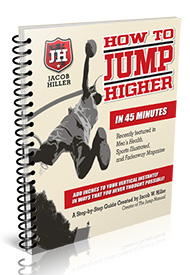
As the name suggests, Instant Inches is all about increasing your vertical jump in a matter of minutes.
This is done not through some magical fairy dust sprinkled on your shoes, but rather by teaching you a few aspects of vertical training that you can implement immediately.
And the result can be amazing…
In this bonus e-book, you’ll learn about the Miracle Static Stretches that help your muscles and tendons develop the full range of motion which can instantly add 2-4 inches to your vertical.
Instant Inches also has a video series that goes deep into every single essential movement of jumping, breaking down the jumping form into easy-to-understand steps.
Finally, there’s a very informative section on palming the ball, which can be very important when you’re close to dunking but just can’t properly stuff the ball in the hoop.
Plateau Busters
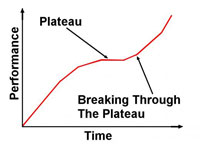 One of the most common problems when training your vertical jump is hitting a plateau.
One of the most common problems when training your vertical jump is hitting a plateau.
Many aspiring dunkers give up on their dream simply because no matter how hard they train, they just can’t make any progress after a certain point.
Luckily, Plateau Busters deals exactly with that.
It’s a very comprehensive questionnaire that allows you to go through each potential problem and figure out exactly what’s keeping you from making progress.
Bodyweight Basketball Training
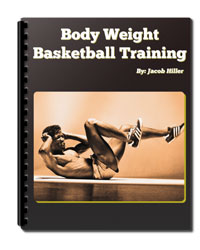 Lastly, for those that don’t have access to a gym or equipment, Jacob has created the Bodyweight Basketball Training module.
Lastly, for those that don’t have access to a gym or equipment, Jacob has created the Bodyweight Basketball Training module.
This module replaces all the weight-based workouts with bodyweight exercises, allowing you to do the program almost anywhere.
While the results might not be the same as at the gym, you can still make solid progress, as the Bodyweight Basketball Training program has carefully selected exercises that replace the weight training exercises almost as well.
Summary
The Jump Manual not only allows you to increase your vertical jump, but it also enhances your basketball skills and overall physical strength and athleticism.
If you’re really serious about improving as a basketball player, it’s one of the best jump training programs you could have.
However, it does require a tremendous commitment on your part, and for many people that have school or a job, it might be too much to follow.
But make no mistake… if you finish the program, you’re guaranteed to have a strong vertical that will improve your game and help you achieve what every baller dreams of, but only a few get – the ability to dunk.

Born and raised in sunny Florida, Jesse Parker grew up spending most of his days outdoors playing hoops and honing his basketball skills. He has a huge love for the game and is always striving to get better at it. His latest obsession is the subject of vertical jumping and dunking.










Good post Jesse!
I appreciate you taking the time to review this product.
You’re welcome.
I noticed you did both Jumpmanual and vert shock. Which one you would recommend between the two?
Depends on age and history but generally if you’re young and you have no history of injuries then go with vert shock as it gives faster results really.
I ordered it and get access to anything sounds like a scam to me i am really pissed off right now
Hey Jeff,
Have you checked your spam folder to see if it’s not there?
If you haven’t received it you can try solving it with their support system?
Just go to here and open a ticket here
https://jumpmanual.zendesk.com/hc/en-us/requests/new
They will get back to you with the login details.
Whoa! Your gains are amazing!
I tried a completely different program but I haven’t got anywhere near 40 inch vertical, I guess I need to change things up.
Great site BTW.
If you would like to obtain a great vertical from from your training then
you have to apply the techniques in the manual to your training.
I’ve tried it myself and it’s really superior to any method I was training before.
This review sealed the deal for me. I had spent a lot of time searching for people who have gone and tried this program but no one really took the time to explain how everything works and share their results!
Thanks!
Glad you’ve found it useful.
Good luck.
Hey Jesse, I found your blog using msn.
This is a very good review. After seen your results I’m now confident I can buy this program. Thanks for the post.
I’ll certainly comeback.
Thanks, you’re welcome.
Superb blog! Do you have any tips for someone who’s starting from scratch?
I’m planning to start training with this program soon and was a little lost on everything but now I’m sure it’s what I need.
Would you recommend starting with a free weights or go for machines?
There are so many choices out there that I’m totally confused ..
Any tips? Cheers!
The biggest thing to watch out for when you’re unconditioned and untrained is injuries.
I really recommend that you take it slow at the beginning.
If you don’t have any experience with free weights definitely go for machines, as you get stronger gradually move to free weight.
In terms of injury prevention there’s a big emphasize on it with the program cause it’s pretty intense, so I would also advise to consult with Jacob, that’s where the 30 day free one on one coaching can help you.
Best of luck.
I’ve been searching for some time for high-quality information about vertical jumping.
Reading about Jacob Hiller’s program I have a very excellent feeling I’ve discovered just what I needed.
I’ll certainly report back on my progress.
Hey I am here for the first time. I came across your blog and I find It really useful. it helped me out a lot.
I am hoping to present results like yours when I finish the 3 month training.
I doubt 3 months will get you a 40 inch vertical but you’ll definitely gain inches that I can tell you.
I stumbled upon your video on youtube and thought I might check things out. I like what I see about this program.
I’m following you. Looking forward to exploring the manual’s effectiveness.
Excellent post. I’m used to checking your blog continuously and I am inspired!
Very helpful review specifically about the training.
Thanks a lot.
Glad I could help.
First off I want to say terrific results! thank you for this review!
Great post.
spent a lot of time researching what vertical jump program to take but I think I’m gonna with this one. great review Jess!
Thanks for sharing the facts Jesse, keep rocking.
DAMN, I just wrote an extremely long comment but accidentally refreshed and my comment disappeared.
Grrrr… well I’m not writing all that over again.
Anyway I’ve just decided that I’m gonna buy jacob’s program and give it a try.
great blog BTW!
Man, it’s truly rocks to see people turn into crazy dunkers with jacob’s program.
Thanks for sharing.
You made some good points there. I checked on the internet to learn more about jacob hiller and this program and it looks awesome. gonna try it…
Hi there, just wanted to say, I enjoy your blog.
It’s very inspiring. Keeep on posting!
Hey there! This post could not be written any better!
Thank you for sharing!
I’m curious to find out what routines have you tried before?
I’m having some minor success with air alert 2 but I would like to find something better.
Does this manual is any similar to air alert?
There’s a huge difference between air alert and this manual, I have friends who used air alert and it sometimes gets you to do huge volume of repetitions, this method is outdated and really doesn’t do much good to your vertical.
With too many repetitions you can’t really get to the improvement zone, you’re just pacing yourself and straining your muscles to fatigue.
This program however is a lot more intense and the workouts are much shorter but you’re training at 80-90% of your capacity and it forces you to squeeze every bit of energy from your legs, it’s much more effective this way since you’re constantly pushing you’re legs to their physical limit.
I don’t leave comments usually but I must say I’m very impressed with your results.
Did you do any other routines besides doing this program?
Well, here and there I did some extra HIIT routines such as tabata to improve my stamina and reactive force but I had to stop because it was diminishing my progress with my vertical.
The program is intense enough as it is, and if you try to incorporate another routine with it won’t work because you need enough time to recover after each workout. What’s funny is my gains started to increase even more after I stopped playing basketball, but it’s because of the same reason.
Can you contact me by skype? I’d like to discuss with you about my vertical…
jerryintk1
Hello Jesse, I’m currently trying this program too and I want to know how many days it took you to see the first results.
Appreciate it if you answer my question.
Subscribed to your blog for updates.
Wow, this is an amazing result! Also, great review, you really analyzed Jacob’s program to the t.
Good program! it’s working great for me, already gained 2 inches after the first month and I was missing workouts too.
Thanks for showing me this program jesse.
Glad to hear that,
Keep us updated!
hey i just bought the manual, where do i go to get it ?
Hey tenzin, you should receive a download link in your email.
If you don’t see the email check your spam folder as it might be there.
I’m seriously considering to buy jacob’s program and I wanna know how many inches I can add without weights.
I have some sets of dumbbbells of 30 lb. can I use that instead?
Well, I would still recommend having a gym ’cause resistance training is important but the program also has non weight alternatives and there are many things you can do with the dumbbells.
How long did it take you to get a 40 inch vertical?
Hey Lens, it took me 7 months to reach it.
Most of the gains were made in the first 3 months, I’ve added 10 inches during that time and after that I gradually worked my way up.
Once you reach the 40 inch bar it’s very hard to make progress but at my peak I had a 42 running vertical so I was very satisfied with the results.
what used to be your vertical?
When I started it was around 25 inches.
All in all I gained almost 17 inches.
hey man..your inspiring video is awesome..I’m 18 years old and 5’8..i can only touch the board.will this program can make me dunk?
To be honest at 5’8″ it’s gonna be tough but with a good plan and a good regimen it’s definitely possible.
What is your current vertical and standing reach?
When did you first get results and by how much?
Hey Lend, I advise you to read this post, all the details are already there.
How many inches was your vertical before the manual?
25 inches.
Hey Jesse,
I was wondering when you did Jump Manual did you add upper body workouts? like bench, military press, curls, etc. Or did you strictly do Jump manual to obtain those awesome results? Just wondering for when I start!
Thanks man! Hope the gains keep coming
Yes of course, I had my own workouts but they had to be toned down and fused together with the manual because the program also has an upper body series of its own so there was no sense doing some things twice.
What did you do after the 3 months to increase your vertical even more?
I kept doin’ the program with some tweaks and changes that Jacob has gave me, but the core stayed the same.
Hi jesse,
i am starting Jump manual program from next month and i can only go to gym 3 days in a week so is it possible to customise the jump manual routine that way. Also i found it doesnt have much upper body so i was thinking about adding few compound upper body workouts is it ok to do so ?
Do so with precaution because you don’t want to overload the body’s capacity to recover, even though it’s in the upper body it might hinder recovery if you don’t adjust accordingly because the body has to allocate more resources to the upper body and that could come at the expense of your legs.
If you have the personal coaching I would advise consulting with jacob about it first, if not, I would test it first slowly.
Always keep in mind to adjust to any routine you add nutritionally and compensate for the extra calories needed to recover.
How much did you pay for this?
When I bought it the retail price was $127. now he just went crazy with the $1 trial he’s offering.
Get in while you can.
Nice review. A lot of work taken.
My friend and I have been using the jump manual for 2 months and have only gained 3 inches. What are we doing wrong?
Recovery, recovery, recovery!!!
That’s usually the #1 reason why most people don’t see gains and that’s what hindered me from seeing results quickly.
Are you following the program exactly as described?
Do you mix it with some other routine?
I follow program exactly and play basketball five times a week and do crossfit three times a week.
That explains it all my friend, your doing so much stuff simultaneously that your body simply can’t keep up, that’s a sure way to hit a plateau. You need to step it down and take a break from your crossfit & basketball training and let your body recover.
Hey jesse
I was wondering if I can touch the elbow at the rim
at 5’7 , standing reach 7’3, I can almost touch my fingers to rim , it mean I have 34 inches , if I use the jump manual maybe I can gain 6 inches or more.
6 inches is actually a modest goal, you can gain a lot more than that with this program.
I follow program exactly and play basketball five times a week and do crossfit three times a week. And my friend and I have only gained 3 inches in 2 months
Hey Nick, see my reply above.
Should I use this while practicing basketball 5 days a week for 2 hours?
You’ll have to reduce your frequency to 2-3 practices max otherwise you’ll hit a plateau fast.
If you can’t do that I’d recommend you to go with the vert shock system instead as it gives you more room for play and it’s a lot more flexible in terms of fitting it into your schedule.
I have seen the kind of dunks your doing and I think your dunks are cool now i have seen this other program also produced by Jacob Hiller called how to jump higher in 45 minutes.My question is this how to jump higher in 45 minutes program is it also another full comprehensive program like the jump manual?
Hey Imanuel, thanks for the words.
No it’s not the full program, it is only a free workbook Jacob offers to help people get started but it’s no where near as comprehensive as the full manual itself.
This is a good review, I will see how this vertical jump training program can help me jump higher in short time.
hey its me again my question is between legpress and squat which of this exercises would you recommend because i find it easier to rapidly increase lower body strength with legpress and you can quickly push heavy weight
You should do both. Squats are obviously more complex than leg presses as they engage your entire body as well as your core muscles. Leg presses are usually good as an isolation exercise for focusing on your legs, they’re generally done after you do the squats.
HOLA CRES Q CON MIS 49 AÑOS,TENIENDO EL JUMP MANUAL Y EL SHOQUE VERTICAL,CUAL ME PUEDE AYUDAR MAS PARA VOLVER A DUNKEAR,MIDO 6.2 Y PESO 205 LBS
Hey Jorge, had to use google translate on your comment to figure out what you’re saying.
Anyway, I’ve addressed your issue in my best vertical jump post and considering your age I recommend that you get jump manual as it’s more safe and friendly to the elder crowd.
I was using jump manual last year and it gave me a result that I couldn’t imagine, I can jump higher and faster without using much of a force and I can grab rebounds from the bigger guys and I can dunk near the rim without jumping in max which means not using your full force..are you still using the jump manual right now I’ve seen great results in Jump Manual for you man what is the best, vert shock or jump manual, because a lot of people say it is vert shock currently…
I’m glad to hear that Dennis, I’m currently off season now but looking to go back to training soon.
If you wanna know which program is best for you I’ve done a post that talks exactly about that in here
http://www.basketballworkouttips.com/adam-folker-system-vertical-workout-program/
hola jesse,llevo 2 semanas con el jump manual y si vi mejoras de 2 pulgadas en mi salto,mi pregunta es si debo aumentar mucho el peso en el levantamiento de pesas o hacerlo mas explosivo?
Hey Jorge, don’t increase the weights yet, keep doing what you’re doing and just stick to the program, no need to change anything so early on.
Hi my name is Marty I am 14 years old I can grab rim right now at 5’9.75 and standing reach 7’6 I started the program in the late summer and saw a 6 inch increase. What I want to know would I be able to dunk within a 6 months ?
Hi Jesse
I don’t have acces to a gym. Is it possible to do the jump manual without machines and weights?
Br. Martin
Yes it is, but it’s less convenient because you have to improvise with stuff like sandbags, books, etc.. where with gym you have exactly the gear you need to do the job.
Some people don’t mind doing this and they prefer the comfort of their own home/garage over the gym, but I personally prefer to have everything set for me and just do what I came to do.
I’ve been jumping after plyos and weightlifting workouts for about 30-60 minutes and play basketball on sundays and test my vertical that day as well. Do you think I’m doing too much? Should I not jump after my workouts?
It depends on how long your workouts take when you combine the plyos, weightlifting and jumps, as well as how intense you do the weight training part. I usually don’t recommend doing weightlifting before jumping, I’d reverse the order and separate those two so that there’s a few hours space between them.
Hey man love your site!
I have some question about Vert Shock:
1) it requires the gym? I mean i need the machines or it’s body weight that i can do in my yard?
2) it’s included some nutrition plan ?
3) it’s an off-season program?
4)you exercise your upper body too?
Thanka for the attention!
Hey Sam.
1) No it doesn’t.
2) Yes.
3) It’s best to do it off-season but you can also do it on-season too.
4) Yes, but for the most part you’re doing leg work.
Thanks for the review just wondering if this program is right for me. I was reading some reviews that said that Jump Manual was better than VertShock. What do you think?
Hey Jack, there are pros and cons to both of them and it depends on the situation.
I recommend you to read this post to understand which one would be better for you.
hey jesse, When Do I need to add more weights 5 pounds every week or more? or less? and What type of protein should my intake be, I know Jacob already mentioned Consuming Whey protein But I’m speaking more of Fish or Chicken and Do I need to separate myself from Fast Food Seeing that I love fast food like taco bell and Ihop? and I am 6’1 weighing 195 is that a good weight for me to be light on my feet or would I need to lose 10 pounds at least? and last but not least I’m 33 Do you think I can still increase 10 inches on my vertical? I am at 20-21 inches currently.
Hey Daniel,
Here are my answers:
“When Do I need to add more weights?”
It depends on the exercise, but, in general, on big compound exercises – 5-15 pound increments, and on small isolated exercises – 2.5-5 pound increments.
The important thing is that you add a weight that still allows you to hit the set x rep range that you’re aiming for.
For example, if you aim to do 3×10 squats, you should only add a weight that enables you to finish that.
“What type of protein should my intake be?”
Lean protein foods such as tuna, chicken breast, low-fat dairy (milk/yogurts/cottage cheese), etc.. Avoid high saturated fat foods.
“I am 6’1 weighing 195 is that a good weight for me to be light on my feet or would I need to lose 10 pounds at least?”
You could lose weight in the process too, just stick to eating clean, doing your workouts regularly, and getting enough sleep – it will happen naturally.
“I’m 33 Do you think I can still increase 10 inches on my vertical?”
Age is not so much of a factor. I’m 37 with one inch less than you and I can still dunk whenever I want. It’s more about your health, your body composition, and your training. Focus on those, and you should be fine.
Jesse,
2 questions.
1) I am on week 10 right now. I have done leg press over squats the whole program so far because I am much more comfortable with that exercise, and I have been able to add 2.5-5lbs each week to my leg press. Should I switch to squats this summer as I continue my training? Am I losing potential gains by choosing leg press over squats?
2) You said you trained for 7 months to get to a 40 inch vert? After your initial 12 weeks, did you take any break, or did you keep going? Did you make any changes after the initial 12 weeks? I am planning to do 6 months total.
Wow, this is an amazing amount of information. I have a 6’2” daughter who loves to play b-ball. We think she is still growing a bit. She plays other sports and has dealt with some knee pain although has not had any knee injuries. She also is playing AAU right now with 3-4 practices a week and sometimes has a weekend tournament. It sounds like she may be playing too much to take on the Jump Manual. What would you advise her to do?
Hey Tony,
It really depends. There are many variables at play here, such as diet, sleep… even genetics.
Also, there’s the issue of time, does she actually have room in her day to work towards this goal?
To be honest, I typically recommend this program offseason because it’s quite taxing on the body and it’s best saved to when the work volume is low. Yes, you can still do it in season, but what usually happens there is that people mess this up either because their diet is off or their training schedule is poorly constructed. Other things could get in the way too, but these are the two main culprits usually from my experience.
On the other hand, the strength gains might really benefit her as you mentioned she’s dealing with some knee pain.
Let me ask you this, does she currently have a weight lifting routine?